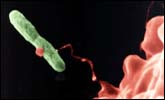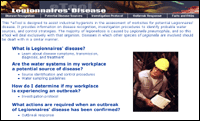| Contents |
 |
|
Page last reviewed: 07/06/2005
|
| Highlights |
 |
|
|

Legionnaires' Disease
It is estimated that in the United States there are between 10,000 and 50,000 cases of Legionnaires' disease each year. Legionnaires' disease is a bacterial disease commonly associated with water-based aerosols that have originated from warm water sources. It is often associated with poorly maintained cooling towers and potable water systems.
There are currently no specific OSHA standards for Legionnaires' disease.
Standards
This section highlights OSHA Federal Registers (rules, proposed rules, and notices), directives (instructions for compliance officers), and national consensus standards related to Legionnaires' disease.
OSHA
Note: Twenty-five states, Puerto Rico and the Virgin Islands have OSHA-approved State Plans and have adopted their own standards and enforcement policies. For the most part, these States adopt standards that are identical to Federal OSHA. However, some States have adopted different standards applicable to this topic or may have different enforcement policies.
Federal Registers
- Indoor Air Quality. Proposed Rules 59:15968-16039, (1994, April 5). Includes a provision that requires employers to implement controls for specific contaminants including Legionella and their sources.
- Search all available
Federal Registers.
Directives
- OSHA Technical Manual (OTM). TED 01-00-015 [TED 1-0.15A], (1999, January 20).
- Legionnaires' Disease. Provides information to assist industrial hygienists in the assessment of work sites for potential Legionnaires' disease, disease recogntion, investigation procedures to identify probable water sources, and control strategies.
- Legionnaires' Disease. eTool. Offers a graphical menu to assist in the assessment of worksites for potential Legionnaires' disease and provides information on disease recognition, investigation procedures, and control strategies.
- Search all available directives.
National Consensus
Note: These are NOT OSHA regulations. However, they do provide guidance from their originating organizations related to worker protection.
American National Standards Institute (ANSI)/American Society of Heating, Refrigerating and Air-Conditioning Engineers (ASHRAE)
- 62-2004, Ventilation for Acceptable Indoor Air Quality, (2006). Sets minimum ventilation rates and other requirements for commercial and institutional buildings.
Hazards and Solutions
The likelihood of contracting Legionnaires' disease depends on the level of contamination in the water source, the susceptibility of the person exposed, and the intensity of exposure. The following references aid in recognizing and preventing hazards associated with Legionnaires' disease in the workplace.
Potential Hazards
Possible Solutions
- OSHA Technical Manual (OTM). OSHA Directive TED 01-00-015 [TED 1-0.15A], (1999, January 20).
- Legionnaires' Disease. Provides information to assist industrial hygienists in the assessment of work sites for potential Legionnaires' disease, disease recognition, investigation procedures to identify probable water sources, and control strategies. The following appendixes are useful in employee education and outbreak response:
- Legionnaires' Disease. eTool. Offers a graphical menu to assist in
the assessment of worksites for potential Legionnaires' disease and provides information on disease recognition, investigation procedures, and control strategies.
- Guidelines for Preventing Health-Care-Associated Pneumonia, 2003. Centers for Disease Control and Prevention (CDC), Morbidity and Mortality Weekly Report (MMWR) 53(RR03);1-36, (2004, March 26). Also available as a 811 KB PDF, 179 pages. Provides information for controlling hospital infections involving Legionella contamination.
- NSW Code of Practice for the Control of Legionnaires’ Disease 2nd Edition 2004. Department of Health, New South Wales, Australia, (2004, June 18). Also available as a 2 MB PDF, 75 pages. Outlines procedures that minimize the risk of infection to personnel working around potential sites of legionellosis infection.
Additional Information
Other Resources
Accessibility Assistance: Contact the OSHA Directorate of Technical Support and Emergency Management at (202) 693-2300 for assistance accessing PDF materials.
|


 Newsletter
Newsletter RSS Feeds
RSS Feeds Print This Page
Print This Page
 Text Size
Text Size


